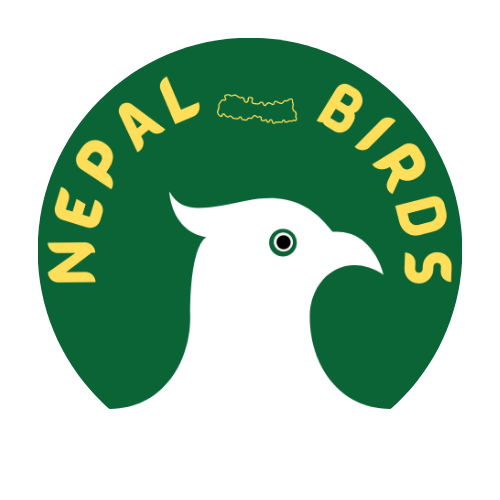540+ Species of Birds Call Chitwan National Park Their Home. It’s Truly a Bird Watcher’s Paradise!
Guided Tours & Packages
Experience the rich biodiversity of Chitwan National Park through curated birdwatching tours, where you can spot over 500 species of birds in their natural habitat.
Travel Tips & Accommodations
As your travel guide, we provide essential tips and accommodation information for an unforgettable birdwatching adventure.
Conservation Efforts
We proudly support and contribute to the ongoing conservation efforts in Chitwan National Park to preserve its rich bird diversity and ecosystems.
Best Locations in Chitwan
Discover the best locations for spotting rare bird species. It’s best to understand that these birds are often distributed across various habitats within the park.
Photography Tips
Learn Jungle Photography tips to snap the best possible photographs of the birds you encounter.
Bird Count Initiatives
We value and promote citizen science initiatives, inviting everyone to contribute to crucial bird data collection.
Birdwatching Seasons
Choose the right season to view the species you want to spot. And, prepare yourself for the right weather conditions.
Resources & References
Browse the most accurate resources and references on birds and nature we’ve put together.
Credit: Clinton Weaver
Overview of Chitwan National Park
Immerse yourself in the vibrant wilderness of Chitwan National Park, a thriving oasis of biodiversity nestled within Nepal. Encompassing an expansive area of 932 square kilometers, the park was established in 1973 and later granted the status of a UNESCO World Heritage Site in 1984. Chitwan is a revered sanctuary that captivates wildlife enthusiasts and birdwatchers alike with its majestic inhabitants and avian diversity. As a visitor, you’ll find yourself in the heart of nature’s grand theatre:
- Engage in the electrifying pursuit of spotting endangered species like the one-horned rhino, Bengal tiger, and a wide array of unique bird species in their organic habitat.
- Delight in the complex behaviors of the park’s wildlife, observing the intricate grazing patterns of rhinos and the harmonious melody of avian calls.
- Uncover the park’s mysteries as you track the movements of diverse wildlife, identify various bird species, and appreciate the rich biodiversity of Chitwan.
- Amplify your visit with a guided tour conducted by seasoned naturalists, equipped with comprehensive knowledge of Chitwan’s birds, wild animals, plant life, and the delicate balance of its ecosystems.
Elevation: Elevation from about 100 m (330 ft) in the river valleys to 815 m (2,674 ft) in the Sivalik Hills.
Climate: The climate in Chitwan National Park is tropical. It experiences three major seasons: Summer (March to June) with temperatures reaching up to 35°C, Monsoon (July to September) with heavy rainfall, and Winter (October to February) with temperatures falling as low as 6°C.
How to Get to Chitwan: To reach Chitwan National Park, you can travel by road from Kathmandu or Pokhara, which will take about 5-6 hours. Alternatively, you can opt for a quick domestic flight from Kathmandu to Bharatpur Airport, followed by a short 30-minute drive to the park.
Best time to visit: Best time to visit Chitwan National Park is during the dry months from October to March, when the wildlife is most visible. However, for avid bird watchers, the period from December to March is particularly rewarding due to the influx of migratory bird species.
As you traverse the captivating wilds of Chitwan National Park, every expedition unravels as a heartfelt conversation with nature, painting an unforgettable picture of Nepal’s untamed beauty. Your exploration is enhanced by guided tours with knowledgeable naturalists who share their insights about the park’s birds, wild animals, plants, and the environment.
Birds of Chitwan at a Glance
Species of Birds, including many endangered ones
Migratory Birds call Chitwan home
Species of Aquatic Birds
Why Chitwan National Park for Birdwatching?
Chitwan National Park is a haven for birdwatchers for several compelling reasons:
- Biodiversity: Chitwan National Park is home to over 540 species of birds, including several endangered species. This rich biodiversity makes it a paradise for birdwatchers, offering the opportunity to spot a wide variety of birds in a single location.
- Migratory Birds: In addition to its resident birds, Chitwan also attracts a significant number of migratory birds, especially during the winter months. This adds to the variety of species that can be observed in the park.
- Unique Habitats: The park encompasses a diverse range of habitats, including forests, grasslands, and wetlands. This diversity of habitats attracts a wide range of bird species, each adapted to its specific environment.
- Conservation Efforts: Chitwan National Park is at the forefront of conservation efforts in Nepal. The park’s successful conservation programs ensure a healthy and sustainable bird population.
- Accessibility: Chitwan is easily accessible from major cities in Nepal, like Kathmandu and Pokhara, making it a convenient destination for both local and international birdwatchers.
- Guided Tours: The park offers guided birdwatching tours, led by experienced guides who have extensive knowledge of the park’s avifauna. These tours can enhance your birdwatching experience, helping you spot and identify a variety of species.
- Scenic Beauty: Apart from birdwatching, Chitwan National Park offers stunning landscapes, from dense jungles and flowing rivers to vast grasslands. The scenic beauty of the park adds to the overall birdwatching experience.

Bird Species in Chitwan
Chitwan National Park, a UNESCO World Heritage Site, is a true sanctuary for birds, boasting over 540 species in its diverse habitats. Chitwan is a birdwatcher’s paradise from the vibrant Bengal Florican and majestic White-rumped Vulture to the melodious Grey-crowned Prinia and the striking Red-headed Trogon.
The park’s rich avifauna represents a significant portion of Nepal’s bird species, making it a prime destination for birdwatchers and nature enthusiasts alike. Whether you’re a seasoned birder or a curious beginner, the bird species in Chitwan offer an unparalleled opportunity to observe, learn, and be captivated by the wonders of avian life.
Ways to Watch Birds in Chitwan National Park
Chitwan National Park offers a multitude of ways to immerse yourself in the world of birdwatching. Whether you prefer the thrill of a jeep safari, the tranquility of a canoe ride, the unique perspective of an elephant ride, or the intimate connection with nature offered by a jungle or nature walk, there’s an option to suit every birdwatcher.
Each method provides a unique lens through which to observe and appreciate the park’s rich avifauna, promising an unforgettable birdwatching experience. Join us as we explore the various ways to watch birds in the diverse and vibrant landscapes of Chitwan National Park.
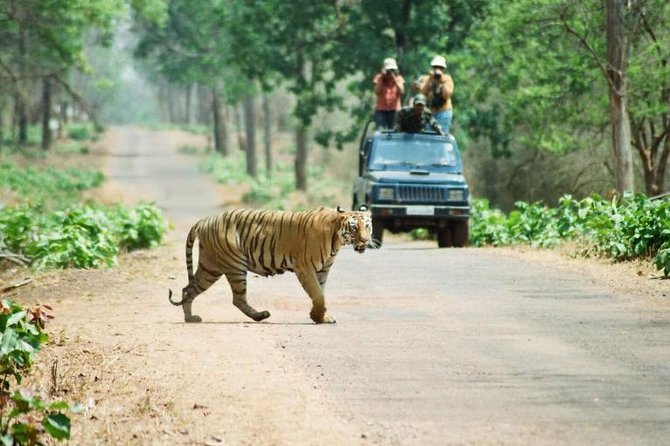
Jeep Safari
A jeep safari allows you to cover a large area of the park in a relatively short time. It’s an excellent way to spot birds that inhabit different habitats within the park, from grasslands to forests. The elevated viewpoint from the jeep can also provide a great vantage point for spotting and photographing birds.
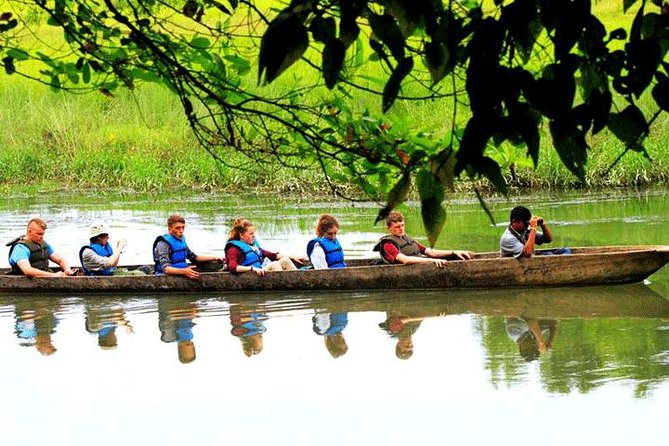
Canoe Ride
A canoe ride along the rivers of Chitwan National Park offers a tranquil and immersive birdwatching experience. It’s an excellent way to spot water birds and other species that inhabit the riverbanks. The slow pace of the canoe ride allows for quiet observation and the opportunity to listen to the sounds of nature.
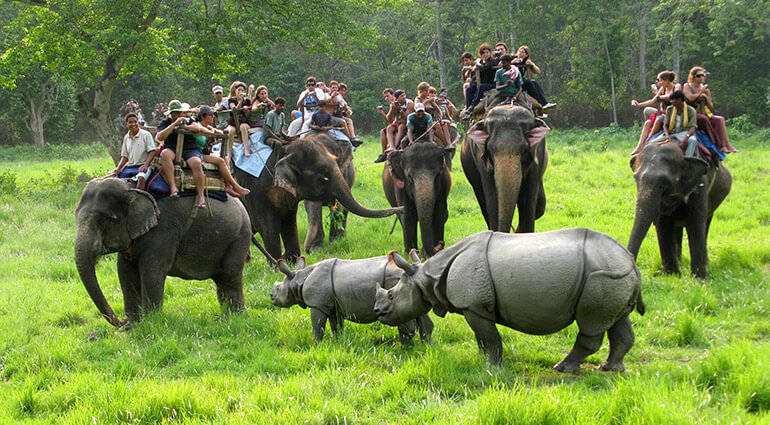
Elephant Ride
An elephant ride offers a unique perspective for birdwatching. The height of the elephant allows birdwatchers to observe tree-dwelling birds more easily. Additionally, elephants can access parts of the park that vehicles can’t, providing opportunities to spot birds in more remote areas.
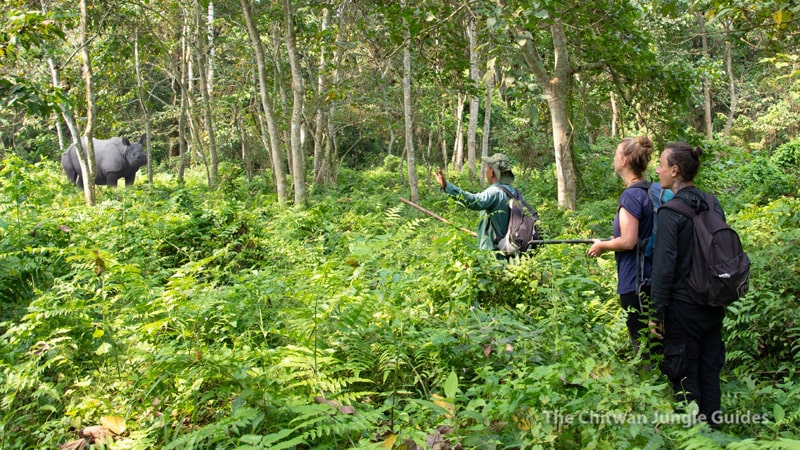
Jungle Walk
A jungle walk, the most preferred method, allows birdwatchers to immerse themselves in the park’s natural environment. Walking quietly along the trails, you’ll have the best chance to spot a variety of bird species while enjoying the serene beauty of the jungle.
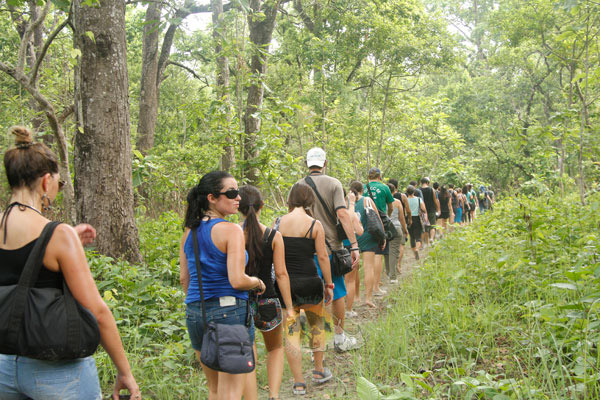
Nature Walk
A nature walk is a slower-paced, more relaxed birdwatching experience. It’s an opportunity to observe birds closely, learn about their behaviors, and appreciate the smaller details of the park’s ecosystem.

Wildlife Photography Tours
Some tours include instruction from a professional wildlife photographer. They can provide tips on camera settings, composition, lighting, and other aspects of wildlife photography.
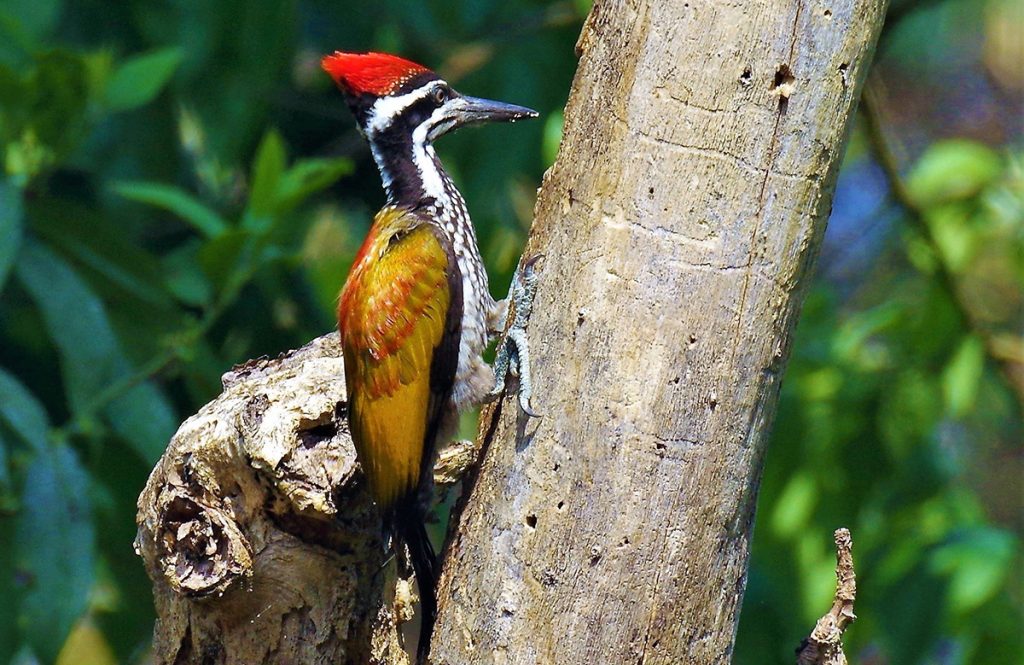
Birdwatching Tips for Chitwan National Park
Chitwan offers an array of unique and exotic bird species that will captivate your senses. However, to make the most of your birdwatching experience, it’s essential to be well-prepared and informed. Whether you’re a seasoned birdwatcher or a novice eager to explore the avian wonders of Chitwan, our tips will equip you with the necessary knowledge to enhance your birdwatching journey.
From the best times to spot different species to the essential gear, you should carry – we’ve got you covered. Let’s embark on this exciting adventure together!
Best Times for Birdwatching in Chitwan
Birdwatching in Chitwan National Park can be a rewarding experience all year round, but certain times are particularly advantageous for spotting a variety of bird species.
- Early Morning: Birds are most active during the early morning hours, making this an ideal time for birdwatching. From dawn until about 10 AM, you’ll find birds feeding and singing, providing excellent opportunities for observation and photography.
- Late Afternoon: The period before dusk is another active time for birds as they feed before nightfall. Plan your birdwatching activities from around 4 PM until sunset for another chance to see a variety of species.
- Seasons: The best season for birdwatching in Chitwan National Park is during the winter months, from October to March. During this period, the park is home to many migratory birds from the northern hemisphere, significantly increasing the variety of species present. The weather is also more pleasant for outdoor activities during these months.
- During and After Rain: Rain can also provide unique birdwatching opportunities. Many birds engage in feeding frenzies after a rain shower, and some species are known to bathe and preen, providing interesting behaviors to observe.
Remember, patience is key in birdwatching. Even during these optimal times, it may take a while before you spot birds, but the wait is often worth the reward.
Note: Birdwatching itineraries differ based on the group size, weather conditions, birding destination, birdwatching duration and service providers in the area.
Recommended Equipment for Birdwatching in Chitwan
Birdwatching in Chitwan National Park is an exciting adventure requiring essential equipment to enhance your experience. Here are some recommendations:
- Binoculars: A good pair of binoculars is a must for birdwatching. They allow you to observe birds closely without disturbing them. Look for binoculars with a good balance of magnification, field of view, and light-gathering ability.
- Field Guide: A field guide such as the Nepal’s Forst Birds will help you identify the species you encounter. Choose one with clear illustrations or photographs and distribution maps.
- Notebook and Pen: Keeping a birdwatching journal can enhance your experience. Note down the species you see, their behaviours, and the locations and times of sightings.
- Camera with Zoom Lens: If you’re interested in bird photography, a good zoom lens will help you capture detailed images from a distance.
- Birding Apps: Several apps can help identify birds, record sightings, and even mimic bird calls.
- Comfortable Clothing: Wear comfortable, breathable clothing in neutral or earth tones to blend into the environment. Long-sleeved shirts and long pants can protect you from insects and underbrush.
- Hat and Sunglasses: Protect yourself from the sun during your birdwatching expedition.
- Insect Repellent: Chitwan National Park is a jungle environment so insect repellent can be helpful.
- Water and Snacks: Birdwatching can involve long periods of walking and waiting, so bring water to stay hydrated and snacks for energy.
- Backpack: A comfortable backpack can help you carry all your birdwatching gear.
Remember, the key to a successful birdwatching trip is patience and preparation. With the right equipment, you’ll be well-equipped to enjoy the avian wonders of Chitwan National Park.
Local Legend and Pioneer Conservationist

Click below to learn more about him and other leading naturalists from Chitwan.

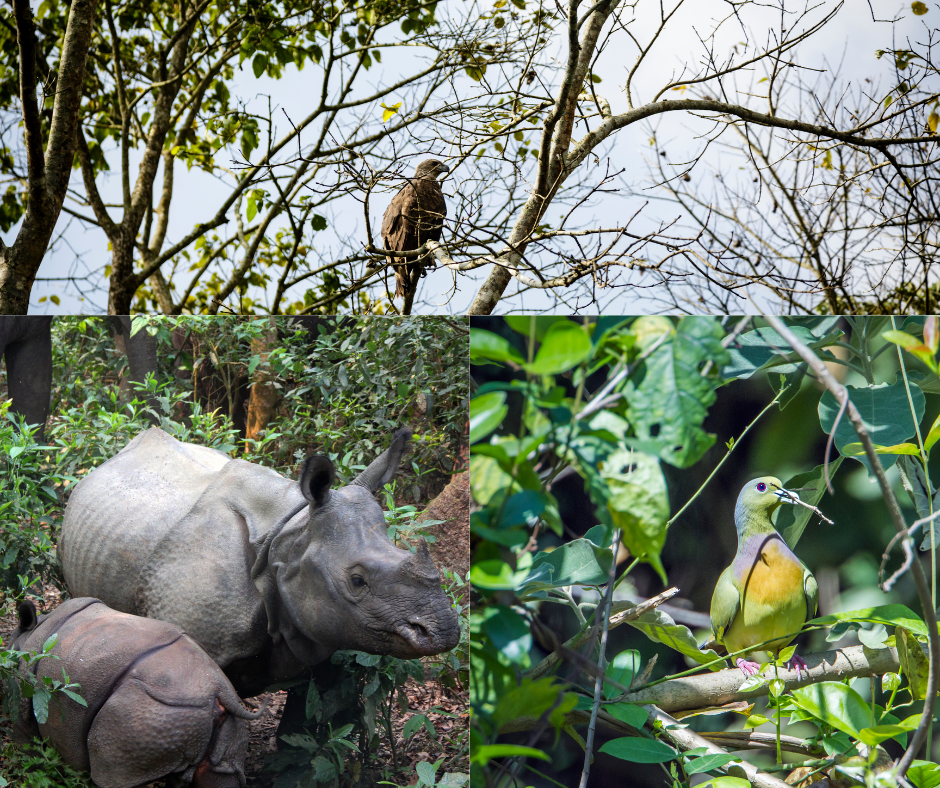
Chitwan Bird Galary









Frequently Asked Questions About Chitwan National Park
Why is Chitwan National Park famous?
Chitwan National Park is famous for its diverse wildlife and is home to some endangered species including the Royal Bengal Tiger and the One-Horned Rhinoceros. It’s also a UNESCO World Heritage Site recognized for its unique biodiversity and ecosystems, which include grasslands, forests, and freshwater habitats.
Is it worth going to Chitwan National Park?
It’s worth visiting Chitwan National Park. It offers a chance to spot rare wildlife, and the park also provides opportunities for cultural experiences with the local Tharu community. Among the myriad activities visitors can enjoy are jungle safaris, elephant rides, bird watching, and canoe rides.
When should I go to Chitwan National Park?
The best time to visit Chitwan National Park is during the dry months of October through March when wildlife viewing is at its best. However, for bird watchers, the months from December to March are particularly rewarding as many migratory bird species visit the park during this period.
How much is the entry fee for Chitwan National Park?
As of my knowledge cutoff in September 2021, the entry fee for foreign nationals is NPR 2,000 per day. For SAARC nationals, the entry fee is NPR 1,000 per day. However, these prices are subject to change, and it’s advisable to check the latest prices on the official website or contact the park authorities before planning your visit.
What wildlife can I see at Chitwan National Park?
Chitwan National Park is home to over 700 species of wildlife. Notable residents include the Bengal Tiger, One-Horned Rhinoceros, Sloth Bear, and Leopard. It’s also a sanctuary for several species of deer, monkeys, and reptiles. In addition, over 540 species of birds have been recorded in the park, making it a birdwatcher’s paradise.
Can I stay overnight at Chitwan National Park?
Several accommodation options, from basic guest houses to luxury jungle resorts, are available in and around the park. These lodgings offer inclusive packages covering meals, jungle activities, and guided tours.
Are there guided tours available in Chitwan National Park?
Yes, guided tours are available and highly recommended. Experienced local guides can enhance your experience by helping you spot and identify wildlife, explaining the park’s ecosystems, and sharing fascinating insights about the park’s flora and fauna.
What is the best way to get to Chitwan National Park?
Chitwan National Park is easily accessible by road from Kathmandu, Pokhara, and other major cities in Nepal. The journey from Kathmandu to Chitwan takes 5-6 hours by road. Alternatively, you can take a short domestic flight from Kathmandu to Bharatpur Airport, which is only a 30-minute drive from the park.
Reaching Chitwan National Park is relatively straightforward with multiple transport options available from major cities in Nepal. Here’s how you can get there:
- By Road: If you prefer scenic views of Nepal’s countryside, you can take a bus or hire a private car from Kathmandu or Pokhara. The journey from Kathmandu to Chitwan takes about 5-6 hours by road, while from Pokhara, it is approximately 4-5 hours. Buses leave daily from Kathmandu’s central bus station for Sauraha, a popular base for exploring Chitwan.
- By Air: For those preferring a quicker journey, a short domestic flight from Kathmandu to Bharatpur Airport is the best option. Bharatpur Airport is just a 30-minute drive from the park. There are daily flights from Kathmandu to Bharatpur which takes approximately 20-30 minutes. From Bharatpur Airport, you can hire a taxi or arrange a pick-up with your hotel.
- By Tourist Bus: There are several tourist bus services that operate from Kathmandu and Pokhara to Chitwan. These buses are more comfortable than local buses and usually include amenities like air conditioning and onboard toilets. The journey takes about 5-6 hours from Kathmandu and 4-5 hours from Pokhara.
Keep in mind that the travel times can vary depending on road conditions and traffic. Make sure to check the current situation and schedule before planning your journey to Chitwan National Park.
